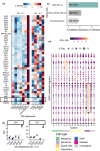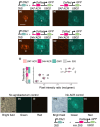Cell-type-aware regulatory landscapes governing monoterpene indole alkaloid biosynthesis in the medicinal plant Catharanthus roseus
- PMID: 39456129
- PMCID: PMC11617651
- DOI: 10.1111/nph.20208
Cell-type-aware regulatory landscapes governing monoterpene indole alkaloid biosynthesis in the medicinal plant Catharanthus roseus
Abstract
In plants, the biosynthetic pathways of some specialized metabolites are partitioned into specialized or rare cell types, as exemplified by the monoterpenoid indole alkaloid (MIA) pathway of Catharanthus roseus (Madagascar Periwinkle), the source of the anticancer compounds vinblastine and vincristine. In the leaf, the C. roseus MIA biosynthetic pathway is partitioned into three cell types with the final known steps of the pathway expressed in the rare cell type termed idioblast. How cell-type specificity of MIA biosynthesis is achieved is poorly understood. We generated single-cell multi-omics data from C. roseus leaves. Integrating gene expression and chromatin accessibility profiles across single cells, as well as transcription factor (TF)-binding site profiles, we constructed a cell-type-aware gene regulatory network for MIA biosynthesis. We showcased cell-type-specific TFs as well as cell-type-specific cis-regulatory elements. Using motif enrichment analysis, co-expression across cell types, and functional validation approaches, we discovered a novel idioblast-specific TF (Idioblast MYB1, CrIDM1) that activates expression of late-stage MIA biosynthetic genes in the idioblast. These analyses not only led to the discovery of the first documented cell-type-specific TF that regulates the expression of two idioblast-specific biosynthetic genes within an idioblast metabolic regulon but also provides insights into cell-type-specific metabolic regulation.
Keywords: idibioblast; single‐cell ATAC‐seq; single‐cell RNA‐seq; transcription factors; vinca alkaloids.
© 2024 The Author(s). New Phytologist © 2024 New Phytologist Foundation.
Conflict of interest statement
None declared.
Figures






References
-
- Bahieldin A, Atef A, Edris S, Gadalla NO, Al‐matary M, Al‐Kordy MA, Ramadan AM, Bafeel S, Alharbi MG, Al‐Quwaie DAH et al. 2018. Stepwise response of MeJA‐induced genes and pathways in leaves of C. roseus . Comptes Rendus Biologies 341: 411–420. - PubMed
-
- Bray NL, Pimentel H, Melsted P, Pachter L. 2016. Near‐optimal probabilistic RNA‐Seq quantification. Nature Biotechnology 34: 525–527. - PubMed
-
- Burlat V, Oudin A, Courtois M, Rideau M, St‐Pierre B. 2004. Co‐expression of three MEP pathway genes and Geraniol 10‐Hydroxylase in internal phloem parenchyma of Catharanthus Roseus implicates multicellular translocation of intermediates during the biosynthesis of monoterpene indole alkaloids and isoprenoid‐derived primary metabolites. The Plant Journal 38: 131–141. - PubMed
MeSH terms
Substances
Grants and funding
LinkOut - more resources
Full Text Sources
Miscellaneous

